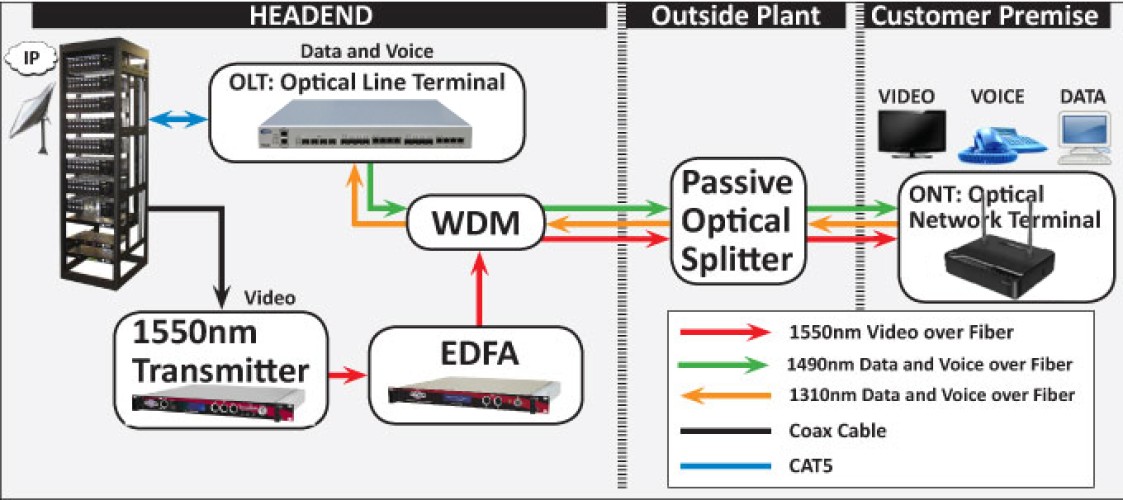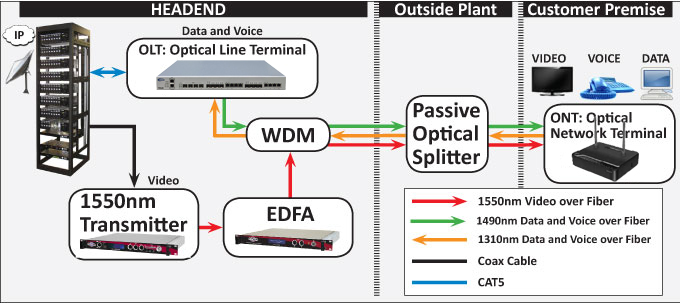
What's The Significance Of ONT In GPON?
What's the significance of ONT in GPON? Well, imagine this: you're soaring the internet, streaming videos, and chatting with friends. But have you ever wondered how all these data magically reaches your devices? Say hello to ONT! It's like a superhero that bridges your home to the vast world of the internet.
Picture this: you're sitting at home, ready to surf the web, when suddenly, your internet connection undergoes a magical transformation. With ONT, you unlock the power of the internet at your fingertips, enabling you to explore, communicate, and learn in ways you couldn't imagine.
So, what exactly is ONT? ONT stands for Optical Network Terminal, a nifty gadget that brings fiber-optic technology right to your doorstep. It's like a gateway that converts signals from your service provider into something your devices can understand. In simpler terms, it's the ultimate translator between the internet and your devices.
Intrigued yet? Let's dive deeper into the realm of ONT in GPON and unravel the secrets behind this remarkable piece of technology that keeps us connected day in and day out. Get ready to embark on a journey through the fascinating world of ONT and discover its significance in the realm of GPON. Are you ready? Let's get started!
The ONT, or Optical Network Terminal, plays a crucial role in GPON, or Gigabit Passive Optical Network. It serves as the interface between the customer's premises and the service provider's network. The significance of ONT in GPON lies in its ability to convert optical signals to electrical signals for use by devices such as phones, computers, and TVs. With advanced features like high-speed data transmission, voice communication, and IPTV services, the ONT enhances the connectivity experience for GPON users.

Understanding the Significance of ONT in GPON
When it comes to GPON (Gigabit Passive Optical Network) technology, the ONT (Optical Network Terminal) plays a crucial role. It serves as the bridge between the fiber optic network and the end-user's equipment, such as routers, phones, and computers. Understanding the significance of ONT in GPON is essential for anyone interested in the workings of modern internet connectivity and telecommunications. In this article, we will delve into the details of ONT and its role in the GPON network.
How ONT Transforms Optical Signals into Usable Data
Optical signals transmitted through the fiber optic network are in a form that cannot be directly used by end-user devices. This is where the ONT comes into play. Equipped with specialized optics and electronics, the ONT receives these optical signals and converts them into usable data formats such as Ethernet, POTS (Plain Old Telephone Service), or Wi-Fi signals. This transformation occurs through a process known as modulation and is crucial for the seamless transmission of information.
Deployment and Installation of ONT in GPON
For ONT to provide connectivity to end-user devices, it needs to be properly deployed and installed within the GPON network. ONTs are typically installed at the customer's premises, connecting to the optical network through a dedicated fiber optic cable. The installation process involves connecting the ONT to the user's devices using Ethernet or Wi-Fi, depending on the specific requirements. Proper installation and configuration of the ONT are vital for ensuring a stable and reliable connection for the end-user.
Benefits of ONT in GPON
The utilization of ONTs in GPON networks brings forth numerous benefits for both service providers and end-users. Here are some of the key advantages:
- High-Speed Internet: ONTs enable the delivery of high-speed internet connections, often reaching gigabit speeds, ensuring users can enjoy seamless browsing, streaming, and downloading experiences.
- Multiple Services on a Single Connection: With the ability to deliver different services, such as internet access, voice, and IPTV (Internet Protocol Television), over a single fiber connection, ONTs eliminate the need for separate lines and connections, simplifying the overall setup and reducing costs.
- Flexibility and Scalability: ONTs offer flexibility and scalability in terms of service offerings. They can adapt to changing customer needs and can easily accommodate additional services or higher bandwidth requirements.
ONT vs. Modems and Routers
While ONTs share similarities with modems and routers, they serve distinct purposes in the GPON network. Modems and routers facilitate connectivity within a Local Area Network (LAN), whereas the ONT focuses on the conversion of optical signals from the fiber optic network into usable data formats for end-user devices. Without the ONT, modems and routers would not be able to communicate with the GPON network, making it a vital component for GPON connectivity.
Tips for Ensuring Optimal ONT Performance
To make the most out of the ONT in GPON, here are some tips for ensuring optimal performance:
- Regular Maintenance: Keep the ONT clean and dust-free, as any obstructions can affect its performance. Regularly clean the ports and ensure proper ventilation around the device.
- Secure Connectivity: Protect the ONT from unauthorized access by setting up strong passwords and enabling security features such as firewalls and encryption.
- Firmware Updates: Stay updated with the latest firmware releases for the ONT. These updates often include bug fixes, performance improvements, and additional features.
Conclusion
In conclusion, the ONT holds significant importance in the GPON network, acting as the intermediary between the fiber optic network and end-user devices. Its role in transforming optical signals into usable data formats and providing high-speed internet connections, multiple services on a single connection, scalability, and flexibility make it a critical component of modern telecommunications. By following tips for optimal performance, users can ensure a smooth and reliable experience with their GPON connectivity.
Key Takeaways: What's the significance of ONT in GPON?
- ONT stands for Optical Network Terminal.
- ONT is a device used in GPON (Gigabit Passive Optical Network) technology.
- ONT serves as the interface between the fiber optic network and the customer's devices.
- ONT enables high-speed internet, voice, and video services to be delivered over the fiber optic network.
- ONT allows for a secure and reliable connection between the network and the customer's premises.
Frequently Asked Questions
Welcome to our Frequently Asked Questions section, where we'll explore the significance of the ONT in GPON. Get ready to dive into the world of fiber optic technology and understand why the ONT plays a crucial role in GPON networks.
What is the ONT in GPON?
The ONT, or Optical Network Terminal, is a device that acts as a bridge between a GPON network and the end user's premises. It is typically installed at the customer's location and is responsible for converting the optical signals transmitted through the fiber optic cables into electrical signals that can be used by various devices within the premises.
The ONT is an essential component of a GPON network as it enables the delivery of high-speed internet, voice, and video services to the end user. It contains ports for connecting multiple devices, such as computers, telephones, and TVs, allowing them to access the services provided by the GPON network.
How does the ONT work in GPON?
The ONT operates by receiving optically encoded data from the GPON network through the optical fiber cables. It then uses specialized electronics to convert these optical signals into electrical signals that can be understood by the customer's devices. The electrical signals are then transmitted to the respective ports on the ONT, where customers can connect their devices.
The ONT also performs several other functions, such as managing the communication between the customer's devices and the GPON network, ensuring data security, and providing advanced features like wireless connectivity and voice services. It acts as a gateway, allowing the end user to access the full range of services offered by the GPON network.
What are the advantages of using an ONT in GPON?
The use of an ONT in GPON brings several advantages. Firstly, it provides a high-speed and reliable internet connection to the end user, thanks to the efficiency of fiber optic technology. This enables faster downloads, smoother video streaming, and better overall performance.
Secondly, the ONT allows for the delivery of multiple services through a single connection. This means that the end user can have internet, voice, and video services all coming from a single device, reducing the need for multiple installations and reducing clutter in the premises. It also simplifies the management of services, making it easier for customers to customize their packages and access additional features.
Can the ONT be upgraded in GPON?
Yes, the ONT in GPON networks can be upgraded to take advantage of new technologies and improved features. Upgrades may involve replacing the existing ONT with a newer model that offers better performance, increased capacity, or additional functionalities. It is important to note that the compatibility of the ONT with the GPON network infrastructure should be considered when planning an upgrade.
Upgrading the ONT can offer benefits such as faster internet speeds, enhanced security features, and support for advanced services. It is recommended to consult with the service provider or network operator to determine the compatibility and feasibility of upgrading the ONT in a GPON network.
Is the ONT necessary for a GPON connection?
Yes, the ONT is essential for establishing a GPON connection. It is the device that enables the transmission of data, voice, and video services between the GPON network and the end user's premises. Without the ONT, it would not be possible to access these services over the fiber optic cables.
The ONT also provides the necessary interfaces and connections for the customer's devices, allowing them to connect and benefit from the services offered by the GPON network. It plays a crucial role in ensuring a seamless and reliable connection between the GPON network and the end user.
GPON Technology Fundamentals | Concepts of PON | GPON Architecture and Principles | GPON vs EPON.
Summary
ONT plays an important role in GPON by connecting users to the internet through fiber optic cables. It converts optical signals into electrical signals that our devices can understand. This allows us to enjoy high-speed internet and access various online services.
ONT helps us connect multiple devices to the internet simultaneously, such as computers, smartphones, and smart TVs. It also provides security features like firewalls to protect our networks from potential threats. Without ONT, we wouldn't be able to enjoy fast and reliable internet connections at home or in businesses. So, next time you browse the web or stream a video, remember the little ONT working behind the scenes to make it all happen!
Recent Posts
- How Does GPON Improve Network Efficiency?
- What Are The Advantages Of GPON?
- What Are The Benefits Of IT Outsourcing?
- What's The Deal With Ransomware Attacks?
- Are GPON Providers Widely Available?
- What's GPON's Impact On Bandwidth?
- Why Is Multi-Factor Authentication Important?
- How To Ensure Data Privacy Compliance?
 Blogs
Blogs Infographics
Infographics Videos
Videos Podcasts
Podcasts Case Studies
Case Studies Call For Quote
Call For Quote